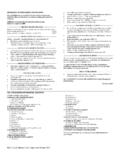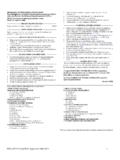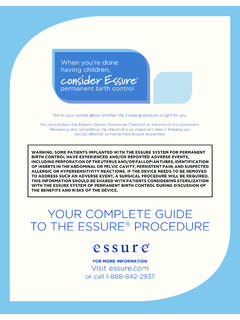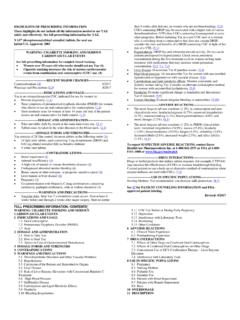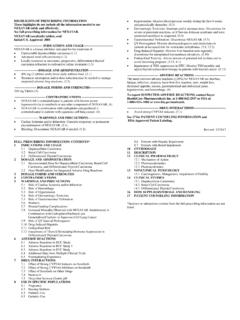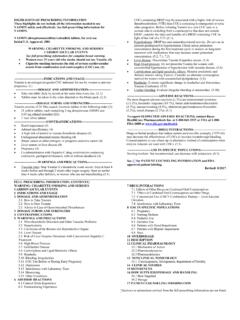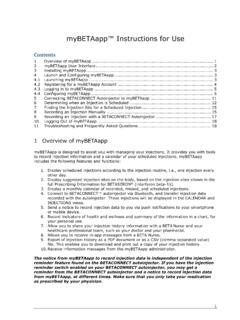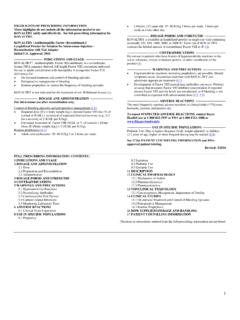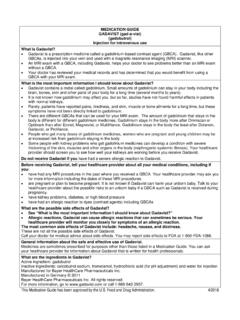Transcription of FDA-Approved Patient Labeling Patient …
1 NDA 21225 Mirena FDA approved 08 June 2017 FDA-Approved Patient Labeling Patient information Mirena (mur- -nah) (levonorgestrel-releasing intrauterine system) Mirena does not protect against HIV infection (AIDS) and other sexually transmitted infections (STIs). Read this Patient information carefully before you decide if Mirena is right for you. This information does not take the place of talking with your gynecologist or other healthcare provider who specializes in women s health. If you have any questions about Mirena, ask your healthcare provider. You should also learn about other birth control methods to choose the one that is best for you. What is Mirena? Mirena is a hormone-releasing system placed in your uterus by your healthcare provider to prevent pregnancy for up to 5 years.
2 Mirena can also lessen menstrual blood loss in women who have heavy menstrual flow and who also want to use a birth control method that is placed in the uterus to prevent pregnancy. Mirena can be removed by your healthcare provider at any time. Mirena can be used whether or not you have had a child. Mirena is a small flexible plastic T-shaped system that slowly releases a progestin hormone called levonorgestrel that is often used in birth control pills. Because Mirena releases levonorgestrel into your uterus, only small amounts of the hormone enter your blood. Mirena does not contain estrogen. Two thin threads are attached to the stem of Mirena. The threads are the only part of Mirena you can feel when Mirena is in your uterus; however, unlike a tampon string, the threads do not extend outside your body.
3 Mirena is small and flexible What if I need birth control for more than 5 years? Mirena must be removed after 5 years. Your healthcare provider can place a new Mirena during the same office visit if you choose to continue using Mirena. NDA 21225 Mirena FDA approved 08 June 2017 What if I want to stop using Mirena? Mirena is intended for long-term use but you can stop using Mirena at any time by asking your healthcare provider to remove it. You could become pregnant as soon as Mirena is removed, so you should use another method of birth control if you do not want to become pregnant. What if I change my mind about birth control and want to become pregnant in less than 5 years? Your healthcare provider can remove Mirena at any time.
4 You may become pregnant as soon as Mirena is removed. About 8 out of 10 women who want to become pregnant will become pregnant sometime in the first year after Mirena is removed. How does Mirena work? Mirena may work in several ways including thickening cervical mucus, inhibiting sperm movement, reducing sperm survival, and thinning the lining of your uterus. It is not known exactly how these actions work together to prevent pregnancy. Mirena can cause your menstrual bleeding to be less by thinning the lining of the uterus. How well does Mirena work for contraception? The following chart shows the chance of getting pregnant for women who use different methods of birth control. Each box on the chart contains a list of birth control methods that are similar in effectiveness.
5 The most effective methods are at the top of the chart. The box on the bottom of the chart shows the chance of getting pregnant for women who do not use birth control and are trying to get pregnant. Mirena, an intrauterine device (IUD), is in the box at the top of the chart. NDA 21225 Mirena FDA approved 08 June 2017 How well does Mirena work for heavy menstrual bleeding? In the clinical trial performed in women with heavy menstrual bleeding and treated with Mirena, almost 9 out of 10 were treated successfully and their blood loss was reduced by more than half. Who might use Mirena? You might choose Mirena if you: Want long-term birth control that provides a low chance of getting pregnant (less than 1 in 100) Want birth control that works continuously for up to 5 years Want birth control that is reversible Want a birth control method that you do not need to take daily Want treatment for heavy periods and are willing to use a birth control method that is placed in the uterus Want birth control that does not contain estrogen Who should not use Mirena?
6 Do not use Mirena if you: Are or might be pregnant; Mirena cannot be used as an emergency contraceptive Have had a serious pelvic infection called pelvic inflammatory disease (PID) unless you have had a normal pregnancy after the infection went away Have an untreated pelvic infection now Have had a serious pelvic infection in the past 3 months after a pregnancy Can get infections easily. For example, if you have: o Multiple sexual partners or your partner has multiple sexual partners o Problems with your immune system o Intravenous drug abuse Have or suspect you might have cancer of the uterus or cervix NDA 21225 Mirena FDA approved 08 June 2017 Have bleeding from the vagina that has not been explained Have liver disease or liver tumor Have breast cancer or any other cancer that is sensitive to progestin (a female hormone)
7 , now or in the past Have an intrauterine device in your uterus already Have a condition of the uterus that changes the shape of the uterine cavity, such as large fibroid tumors Are allergic to levonorgestrel, silicone, polyethylene, silica, barium sulfate or iron oxide Before having Mirena placed, tell your healthcare provider if you: Have had a heart attack Have had a stroke Were born with heart disease or have problems with your heart valves Have problems with blood clotting or take medicine to reduce clotting Have high blood pressure Recently had a baby or if you are breastfeeding Have severe migraine headaches How is Mirena placed? Mirena is placed by your healthcare provider during an in-office visit.
8 First, your healthcare provider will examine your pelvis to find the exact position of your uterus. Your healthcare provider will then clean your vagina and cervix with an antiseptic solution, and slide a slim plastic tube containing Mirena into your uterus. Your healthcare provider will then remove the plastic tube, and leave Mirena in your uterus. Your healthcare provider will cut the threads to the right length. Placement takes only a few minutes. You may experience pain, bleeding or dizziness during and after placement. If your symptoms do not pass within 30 minutes after placement, Mirena may not have been placed correctly. Your healthcare provider will examine you to see if Mirena needs to be removed or replaced.
9 Should I check that Mirena is in place? Yes, you should check that Mirena is in proper position by feeling the removal threads. It is a good habit to do this once a month. Your healthcare provider should tell you how to check that Mirena is in place. First, wash your hands with soap and water. You can check by reaching up to the top of your vagina with clean fingers to feel the removal threads. Do not pull on the threads. If you feel more than just the threads or if you cannot feel the threads, Mirena may not be in the right position and may not prevent pregnancy. Use non-hormonal back-up birth control (such as condoms and spermicide) and ask your healthcare provider to check that Mirena is still in the right place.
10 How soon after placement of Mirena should I return to my healthcare provider? Call your healthcare provider if you have any questions or concerns (see "When should I call my healthcare provider"). Otherwise, you should return to your healthcare provider for a follow-up visit 4 to 6 weeks after Mirena is placed to make sure that Mirena is in the right position. Can I use tampons with Mirena? Tampons may be used with Mirena. What if I become pregnant while using Mirena? NDA 21225 Mirena FDA approved 08 June 2017 Call your healthcare provider right away if you think you are pregnant. If you get pregnant while using Mirena, you may have an ectopic pregnancy. This means that the pregnancy is not in the uterus.
